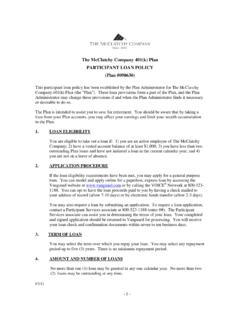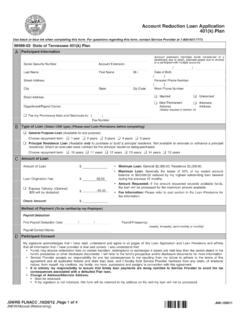Transcription of Effects of Corporate Mergers, Acquisitions and Dispositions
1 Effects of Corporate mergers , Acquisitions and Dispositions By Arthur H. Tepfer, , Corporate transactions, especially mergers and Acquisitions , affect the company and the employees in more ways than are often realized. One of the more interesting side Effects of a merger or acquisition is the effect on both the buyer and the seller s 401(k) plan . Special rules, often tucked away in the IRS regulations, are frequently neglected or, worse, not followed at all. Let s look at some of these rules which are often misinterpreted or misapplied. In order to understand what is going on we need to establish some workable definitions.
2 The Internal Revenue Code is a good place to start. Hidden away in the regulations under Code Section 401(a)(4) -- that s the general section which discusses plan discrimination -- is the definition of acquired group of employees . The regulation says, in typical government gobbledygook, that these employees are employees of a prior employer who become employed by the employer in a transaction between the employer and the prior employer that is a stock or asset acquisition , merger or other similar transaction involving a change in the employer of the employees of a trade or business.
3 Plus employees hired by or transferred into the acquired trade or business on or before a date selected by the employer that is within the transition period defined in Section 410(b)(6)(C)(ii). [emphasis added] Simply put, it s the people you hire from the other company after the transaction plus any people from your own company who are transferred. The transition period referred to is essentially the period starting with the date of the transaction and ending on the last day of the plan year which starts after the transaction. Still confused?
4 Let s look at an example. company A buys company B on June 1, 1998 and forms a new division of company A. On June 1, 1999, company A then moves some of it s employees into this new division. All of the employees of this new division are considered to be part of the acquired group of employees . Assuming that you have a 401(k) plan with a calendar plan year, this acquired group exists until December 31, 1999 . Seems all fine and dandy but what practical advantage does it have? Well--the regulations let you do almost all of your testing separately for the non-acquired employees and the acquired group of employees.
5 This testing includes general discrimination testing, participation, average deferral percentages, match percentages, benefits rights and features, etc. Additionally, since the testing can be done separately for each group, you can use different definitions for testing. Perhaps you are having problems with deferral percentage testing during a particular year. Would the use of the current year method rather than the prior year method help if it can be applied to only one smaller group of employees. What about the fact that the prior company s 401(k) plan had a different match than your plan ?
6 If you test this group separately you may find that there is no general discrimination. Of course, you don t have to test separately for these employees. They can be brought into your general group and combined for the testing purposes. But it is an all or nothing situation. If you combine them for testing deferral percentages you also must combine them for contribution percentage testing and rights and features testing. No cherry picking allowed. Either option is available as long as there is consistency. Rights and features testing gives you even more leeway than just during the transition period.
7 Under special rules contained in the regulations, rights and features are forever. As long as the right and feature existed in the prior plan before the acquisition or merger, it can continue to be provided to the acquired group of employees (and no other employees) for the plan year of the transaction and all subsequent plan years. This is a government gimmee . What are rights and features? Again let s look at the regulations for some general guidelines. Rights and features include, but are not limited to-- plan loan provisions (other than those relating to a distribution of an employee's accrued benefit upon default under a loan); The right to direct investments.
8 The right to a particular form of investment, including, for example, a particular class or type of employer securities (taking into account, in determining whether different forms of investment exist, any differences in conversion, dividend, voting, liquidation preference, or other rights conferred under the security); The right to make each rate of elective contributions, after-tax employee contributions, and allocation of matching contributions ..; The right to purchase additional retirement or ancillary benefits under the plan ; and The right to make rollover contributions and transfers to and from the plan .
9 Remember, the acquired group also includes some of your current employees who are transferred into this entity. There don t seem to be any formal rules regarding this. Can one simply choose some of the problem testing employees and assign them to a new division for testing purposes? How long do we have to keep them there after the acquisition ? Is this a planning opportunity? Is this a way to give a higher match to certain employees without discrimination? These questions remain unanswered. I do suggest, however, that you review the options with your consultants and competent legal counsel.
10 But enough about the s look at how the transaction affects the employees of the acquired group. Here we can look not only to the regulations but also to some revenue rulings and a new important private letter ruling. Generally, distributions from 401(k) plans are only permitted when a participant dies, becomes disabled, attains age 59 or separates from service. This last clause--the separation from service -- is what can cause some problems. In determining whether an employee has actually separated for purposes of receiving favorable tax treatment on the distribution, Revenue Ruling 79-336 provides that an employee is considered to be separated only upon death, retirement, resignation, or discharge and not when an employee continues in the same job for a different employer as a result of the liquidation merger, or consolidation, etc.







